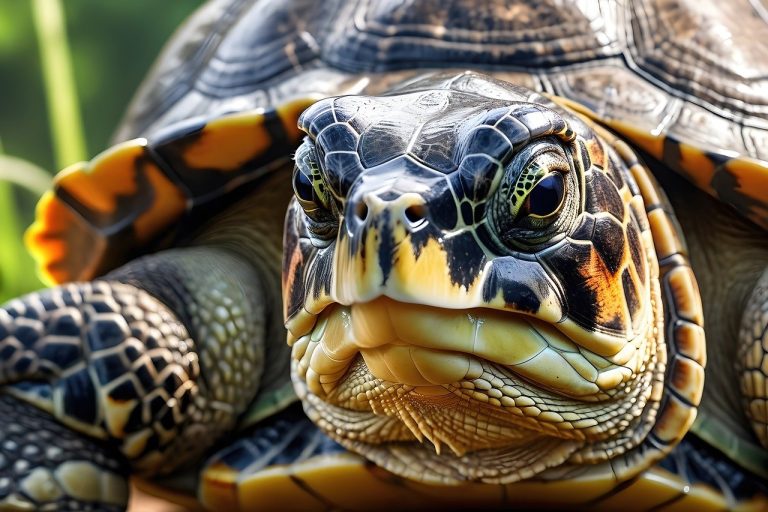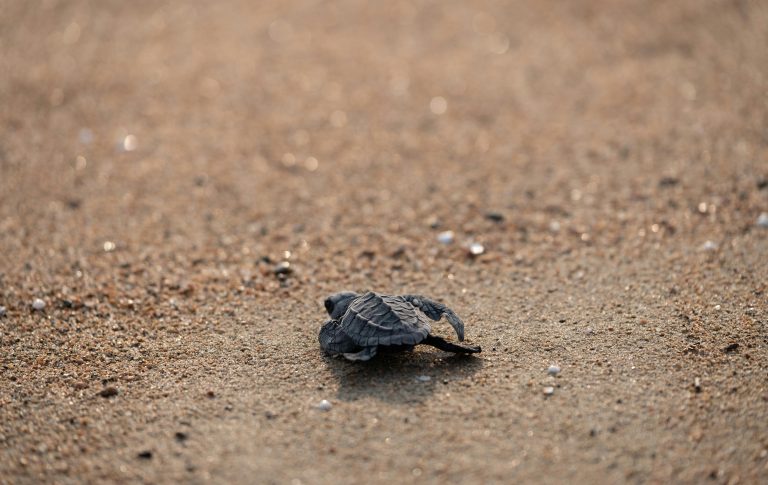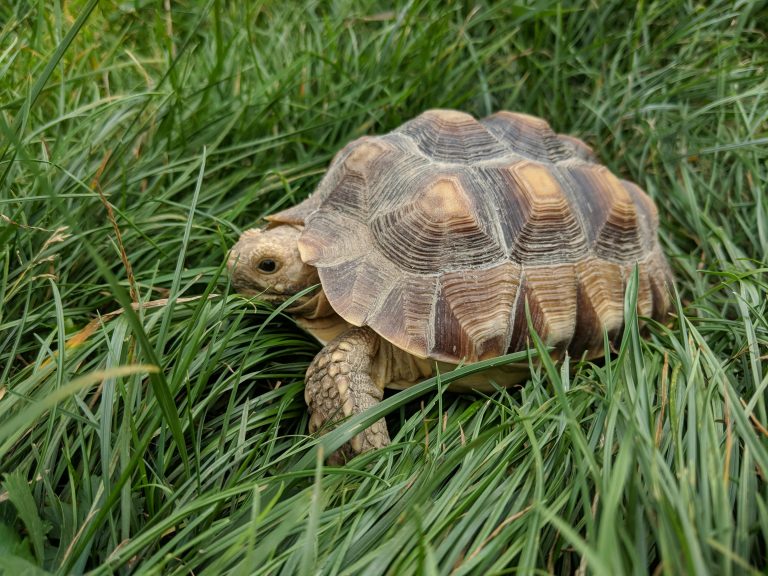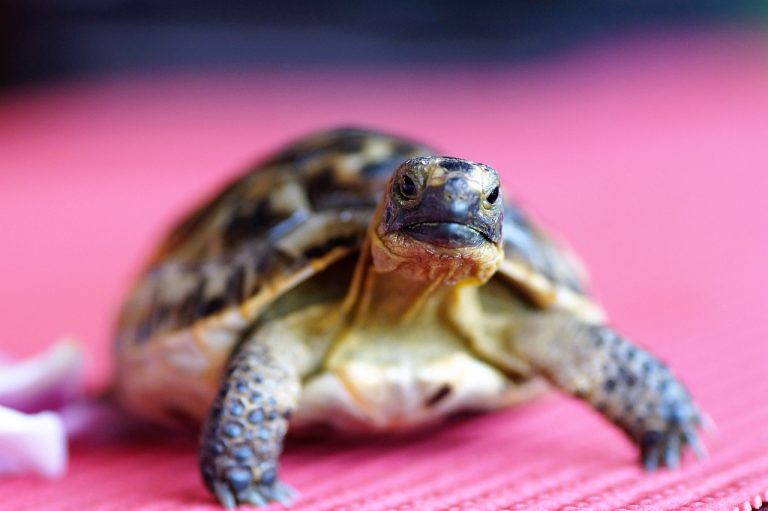5 Tortoise Shell Problems & Way To Treat Them
Many people mistakenly believe that tortoises feel nothing on their shells, leading them to overlook shell diseases as inconsequential. However, shell problems in tortoises can be incredibly serious and even fatal, ultimately leading to the premature death of these pets. It’s essential for tortoise owners to recognize the importance of shell health and promptly address any issues to ensure the well-being and longevity of their beloved pets.
Pyramiding:
- Main Cause: Overfeeding, particularly foods high in protein and low in fiber.
- Treatment: Implement a strict diet regimen, focusing on high-fiber, low-protein foods to prevent further shell growth abnormalities.
Shell Rot:
- Main Cause: Damage to the shell and unsanitary living conditions.
- Treatment: Clean the affected area thoroughly with antiseptics to remove any infections. Apply healing creams or ointments to promote shell regeneration.
Shedding Issues:
- Main Cause: Infections during the shedding process.
- Treatment: Administer antibiotics to combat any bacterial infections that may arise during shedding. Ensure the environment is clean and well-maintained to prevent future infections.
Metabolic Bone Disease (MBD):
- Main Cause: Inadequate exposure to quality UV light, leading to calcium and other nutrient deficiencies.
- Treatment: Provide proper UV lighting using reptile-specific lamps to aid in calcium absorption. Additionally, offer dietary supplements to address any nutrient deficiencies and promote healthy shell growth.
Shell Injuries:
- Main Cause: Trauma from crushing, accidents, or fights with other animals.
- Treatment: Carefully clean and disinfect the wound to prevent infection. Depending on the severity of the injury, it may require veterinary attention for proper repair and healing.
It’s crucial for tortoise owners to monitor their pets’ shell health regularly and provide appropriate care and environment to prevent these common shell diseases. Prompt recognition and treatment can significantly improve the prognosis and overall well-being of the tortoise.
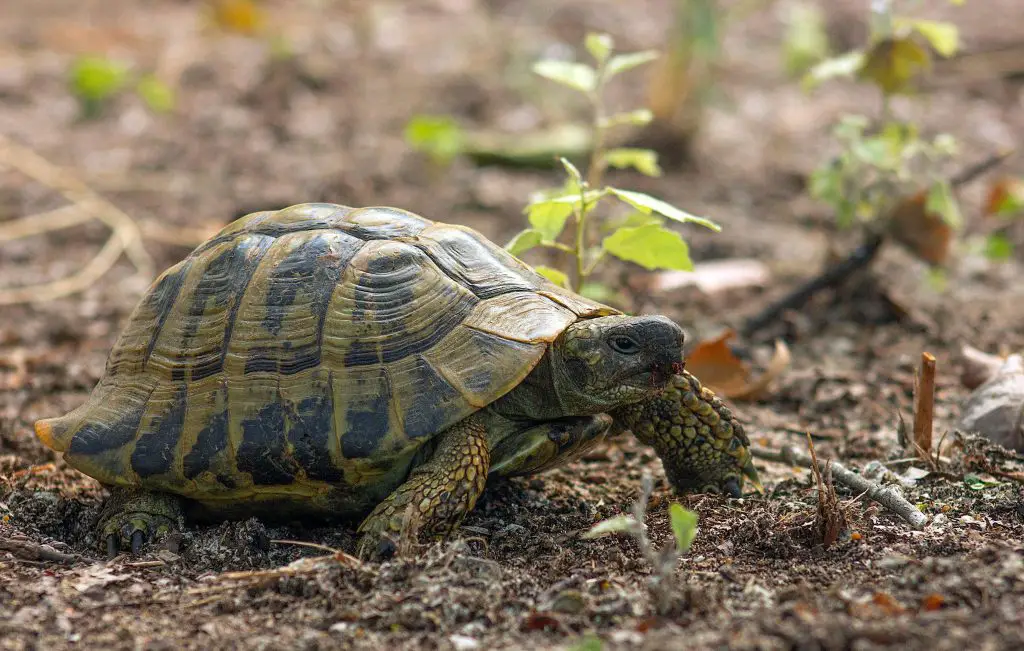
5 Tortoise Shell Problems & Way To Treat Them
Turtles are particularly susceptible to infectious shell diseases due to their aquatic habitat. Although the likelihood of such conditions occurring in tortoises is relatively low, it’s still a possibility that cannot be entirely disregarded.
The shells constitute a crucial component of the tortoise’s skeletal structure, fused with their ribs and housing nerves beneath the carapace. This anatomical setup implies that tortoises can indeed perceive any touch or pain experienced on their shells. Consequently, it’s essential for owners to possess at least a basic understanding of shell disorders and their treatments to alleviate the discomfort of an ailing pet.
I have included 5 most common tortoise shell problems and their treatment below,
1. Pyramiding
Pyramiding, a condition seen in tortoises, manifests as excessive and bumpy growth of the scutes. The irregular development of these scutes gives the shell a resemblance to miniature pyramids, hence the name. This condition solely affects the carapace of the tortoise.
Initially perceived as a minor ailment, pyramiding can have severe consequences, even leading to premature death in tortoises. It affects the central ridges on the carapace and the ribs’ coastal areas, potentially interfering with lung function and causing breathing difficulties. Furthermore, abnormal shell growth may result in weakened legs, leading to limping and potential issues such as arthritis and overgrown toenails.
The implications of pyramiding extend to reproduction, with male tortoises experiencing difficulties in mounting females for mating due to the uneven shell. Gravid tortoises afflicted with pyramiding face challenges in egg-laying. In rare cases, paralysis can occur as the bumps on the upper shell stress the spinal cord and disrupt the nervous system.
Certain tortoise species, including the Sulcata tortoise, red-footed tortoise, star tortoise, Hermann’s tortoise, and Leopard tortoise, are more prone to pyramiding, with young tortoises at higher risk compared to babies and adults.
Overfeeding of protein stands as the primary cause of pyramiding, although tortoises are primarily herbivorous. Symptoms include bumpy scutes on the carapace and difficulty walking, with causes ranging from overfeeding to metabolic bone disease, genetics, and inadequate UV light exposure and humidity levels.
To address and prevent pyramiding, it’s crucial to maintain a strict diet regimen for tortoises, focusing on high-fiber, low-calorie, and low-protein foods such as grass, weeds, vegetables, and greens, with minimal protein intake. Supplementation is necessary to counter mineral deficiencies, ensuring a balanced phosphorus-calcium ratio in the diet. Humidity levels in the enclosure should be maintained between 40 – 90%, with adequate sunlight exposure or quality UV lamps for indoor habitats. Encouraging exercise by providing obstacles and opportunities for grazing aids in preventing obesity and promoting overall health in tortoises.
2. Shell Rot
Shell rot, also known as ulcerative shell disease, is a bacterial infection that affects both the carapace and plastron of tortoises. This infectious condition thrives in unclean environments, making tortoises with cracked or scratched shells particularly susceptible.
Bacteria or fungi enter the tortoise’s shell through wounds, where they proliferate and cause black tinting or spots around the injury. If left untreated, shell rot can become severe, potentially leading to the detachment of entire shell plates and resulting in a distressing demise for the tortoise.
Early detection and treatment are crucial to prevent the infection from spreading to internal organs and tissues. Therefore, it’s essential for owners to regularly inspect their tortoises for any signs of shell damage and maintain a hygienic habitat.
Symptoms of shell rot include cracked or scratched scutes, discolored or black-patched scutes, red spots around injuries, smelly discharge, flaky scutes, loss of appetite, and lethargy. Common causes of shell damage include falls, accidents, fights, and low-humidity environments.
Treatment involves thorough cleaning of the tortoise enclosure and isolating the affected tortoise to prevent the spread of infection. Placing the tortoise in a warm, clean environment under a heating lamp promotes healing. The wound should be cleaned with a soft bristle brush and treated with chlorhexidine solution followed by a healing cream. Home treatment may not be possible if shell plates detach, necessitating immediate veterinary attention.
To aid recovery, maintain cleanliness in the tortoise habitat, change water daily, replace substrate regularly, remove sharp edges, and ensure suitable humidity levels.
Regular monitoring and proactive measures are essential to prevent and manage shell rot, safeguarding the health and well-being of pet tortoises.

3. Metabolic Bone Disease
Metabolic Bone Disease (MBD), often referred to as soft shell, is a condition where tortoises experience softness in their scutes. This ailment arises from insufficient exposure to quality UV light or a lack of direct sunlight in the enclosure.
For tortoises to develop a sturdy skeletal structure, they require adequate levels of vitamin D3 and calcium. However, inadequate UVB exposure prevents the production of vitamin D3 and the absorption of calcium, leading to the onset of MBD.
Soft shells in tortoises can result in permanent damage if left untreated, with baby tortoises afflicted with MBD often failing to fully recover even as they reach adulthood. Gravid tortoises suffering from metabolic bone disease are at risk of egg binding, as the lack of calcium prevents eggshell hardening, potentially leading to severe complications and even death.
Diagnosis of MBD typically involves blood sampling and bone x-rays performed by a veterinarian to assess bone density, guiding subsequent treatment protocols.
Symptoms of MBD include soft scutes, limping, limb fractures, lumps and bumps along the limbs, spinal cord, and jaw, softening of bones and jaws, and loss of appetite.
Common causes of MBD include inadequate UV light, lack of calcium, and calcium-phosphorus imbalances.
Treatment and prevention strategies for MBD include incorporating calcium and vitamin D supplements into the tortoise’s diet, ensuring a 4:1 calcium-phosphorus balance in food, and providing quality UV lighting in the tortoise enclosure. For medium and large tortoises, creating an outdoor habitat with ample sunlight exposure can be beneficial.
It’s essential to consult a veterinarian if MBD symptoms worsen or if the condition becomes uncontrollable, ensuring appropriate medical intervention and management.
4. Injured Shell
Tortoises, despite their leisurely pace, lead active lives driven by their curious and dominant nature, which sometimes leads them into trouble, resulting in shell injuries. Several causes contribute to shell damage in tortoises:
- Accidents: While tortoise shells are remarkably sturdy, capable of withstanding up to 200 times their own weight, collisions with vehicles can crush scutes and open the shell. This is a common occurrence among wild tortoises.
- Heavy Falls: Given their substantial weight, mishandling tortoises can lead to significant shell damage. Even a fall from a relatively low height can result in shell cracks or punctures.
- Attacks: Tortoises retreat into their shells when sensing danger, but they remain vulnerable to attacks from predators. Strong bites from predators or injuries sustained during fights or mating can cause scratches, minor cracks, or other damage to the shell.
Treatment of shell injuries involves:
- Cleaning the injured scute with an antibacterial solution.
- Applying a bandage to cover the wound and minimize the risk of infection.
- Ensuring the injury remains dry and avoiding contact with water.
- Seeking veterinary assistance for treating cracks, which may involve wiring the damaged areas and filling them with a composite mixture of epoxy, resin, and fiberglass cloth.
- The pet may require composite replacements as its shell grows annually.
While tortoise shells can heal naturally over time, waiting for natural healing is not advisable due to the risk of complications such as shell rot. Depending on the severity of the injury, complete healing may take several years. Keeping the injury exposed during this period increases the risk of complications, emphasizing the importance of prompt and proper treatment.
5. Shedding
Many people are unaware that tortoises shed their shells and skins every few months—a natural process indicative of growth and essential for maintaining immunity against various diseases. However, not all sheddings are healthy, and experts have identified instances where shedding occurs due to infection, a concerning phenomenon that signals underlying health issues.
Symptoms of unhealthy shedding in tortoises include skin inflammation, shell rot, black patches on the scutes, changes in scute patterns, damaged shell plates, and a continuous cycle of shedding.
Treatment for unhealthy shedding involves identifying and addressing the underlying health issue. This may include administering antibacterial treatments for infectious diseases.
Furthermore, attention should be given to the tortoise’s habitat. Ensure that UV lights are functioning correctly, and the enclosure receives adequate warmth. Maintaining moisture levels is crucial, achieved by misting the enclosure twice daily.
Maintaining a healthy environment and providing a balanced diet will aid in the tortoise’s recovery from unhealthy shedding, promoting overall well-being.
4 Tips To Keep Tortoise Shells Healthy
Maintaining a healthy shell in tortoises is not as challenging as it may seem. In fact, adhering to four basic rules can ensure the well-being of your pet:
- Proper Diet: Offer a balanced and nutritious diet rich in calcium, vitamins, and minerals. Tortoises primarily thrive on a diet of grass, weeds, vegetables, and greens. Ensure the calcium-phosphorus ratio is adequate, typically aiming for a 4:1 ratio, to support shell health.
- Adequate UV Exposure: Provide access to quality UV lighting or natural sunlight. UV light is essential for vitamin D3 synthesis, which aids in calcium absorption and shell development. Make sure the tortoise’s enclosure receives sufficient UV exposure for optimal health.
- Hygiene Maintenance: Keep the tortoise’s habitat clean and hygienic. Regularly clean the enclosure, remove waste promptly, and provide clean water for drinking and bathing. Maintaining cleanliness helps prevent bacterial growth and reduces the risk of shell infections.
- Regular Health Monitoring: Monitor your tortoise’s shell regularly for any signs of damage, disease, or abnormal growth. Promptly address any issues by seeking veterinary advice and providing appropriate treatment. Regular health checks help prevent and address shell-related problems before they escalate.
By following these four fundamental rules, you can ensure the maintenance of a healthy shell in tortoises, promoting their overall well-being and longevity.
Frequently Asked Questions
Can you put Vaseline on a tortoise shell?
You should not put Vaseline on a tortoise shell. The creamy texture keeps the tortoise scutes damp for a long time and traps bacteria. As a result, the risk of an infectious shell disease increases.
Can tortoises feel their shell being touched?
Tortoise shells are not as sensitive as their skin. But yet, these creatures can feel what is going on with the carapace or plastron. In fact, there are nerve systems running under the shell, which is responsible for any sensitivity of these tortoises.
Can you put coconut oil on a tortoise shell?
Neither coconut oil, olive oil, lotion, nor conditioner is suitable for a tortoise shell. Though these make the scutes shiny, they barely do any good to the plates. Instead, these chemical-treated formulas can damage the shell.
Conclusion
Not only are shell diseases a concern for tortoises, but they can also suffer from various other ailments such as kidney damage, mouth rot, and hypovitaminosis. Prompt treatment is crucial to alleviate the suffering of these creatures.
Be vigilant for signs of illness in your tortoise, as early detection can greatly improve their prognosis and comfort. Ignoring these signs could lead to premature death.
However, I’m unable to access external links, but I can provide information on common signs of illness in tortoises based on general knowledge.
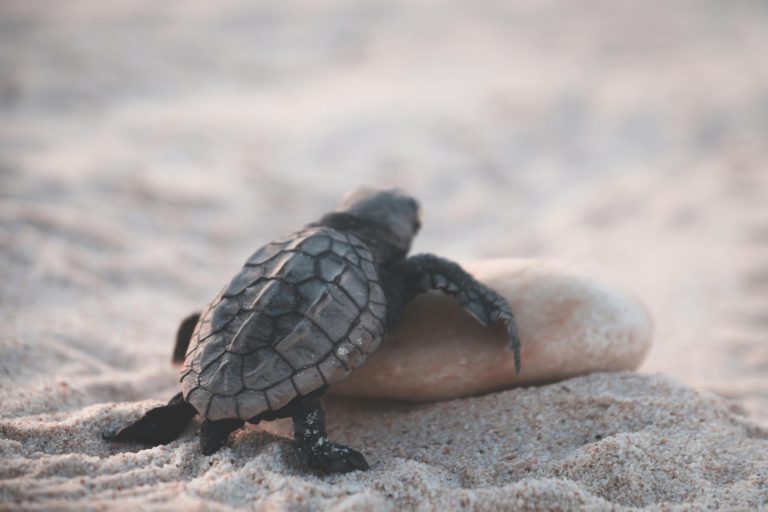
![Why Did My Sulcata Tortoise Die? [8 Probable Reasons]](https://spreadhapiness.com/wp-content/uploads/2024/03/sulcata-t-2-768x512.jpg)
